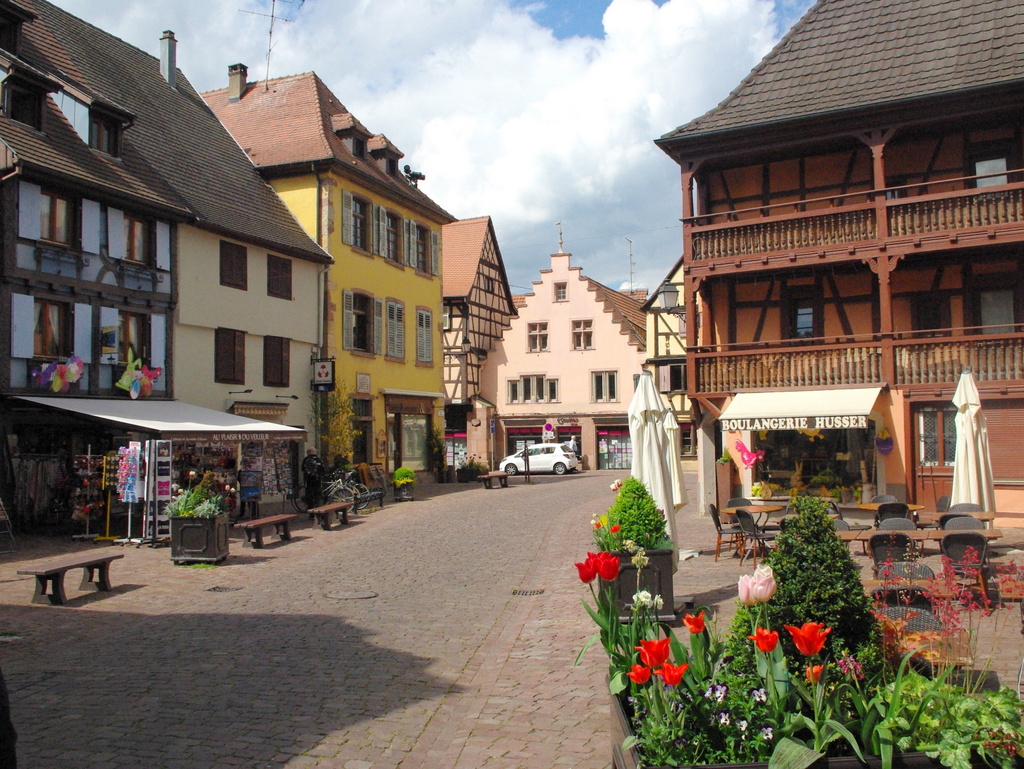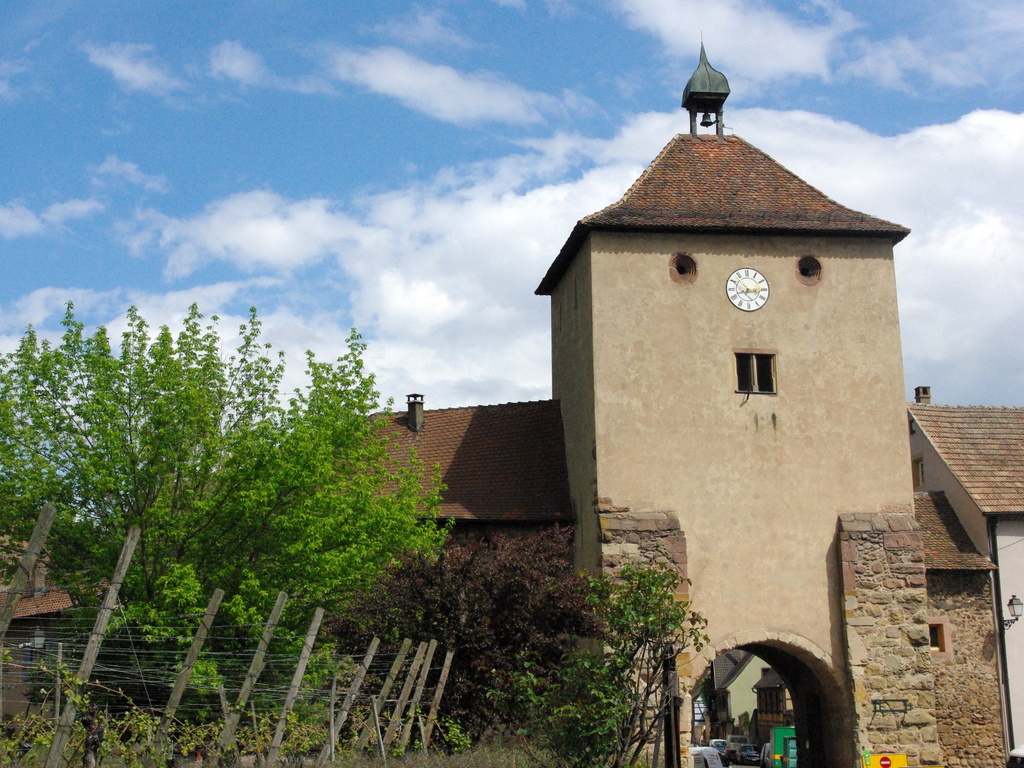The little town of Turckheim lies on the eastern slopes of the Vosges, six kilometres east of Colmar in the département of Haut-Rhin (Alsace). A wealthy Free town during the Middle Ages, Turckheim has become a reputed stop along the Alsace Wine Route.
Turckheim: a bit of History

Commanding the entrance to the Valley of Munster and the route towards Lorraine beyond the pass of Col de la Schlucht, Turckheim enjoyed a strategic position during the Middle Ages. It is therefore not surprising to find remnants of fortified structures.
In 1312, Turckheim was granted the status of Free Imperial City and started the construction of fortifications in 1315. In 1354, the city joined the Décapole, an alliance formed the same year by 10 Imperial cities of the Holy Roman Empire in Alsace which aimed to maintain their rights (Haguenau, Colmar, Wissembourg, Obernai, Kaysersberg, Rosheim, Munster, Sélestat, Mulhouse [until 1515], Seltz [1358-1418] and Landau [from 1521]).
The town went through the terrible events of the Thirty Years’ War (1619-1648) which ended with the annexation of the Habsburgs’ possessions in Alsace to France. At first, Turckheim and the free cities of the Décapole refused to submit to the authority of the king of France.
Turckheim was the site of a memorable confrontation during the Franco-Dutch War: the Battle of Turckheim fought on 5 January 1675. The army of France commanded by the Viscount of Turenne battled the Imperial armies of Austria and Brandenburg led by Frederick William, Elector of Brandeburg. The Treaty of Peace of Nijmegen signed in 1678 finally confirmed Turckheim as part of the kingdom of France.
In 1871, Turckheim and the rest of Alsace were annexed by Prussia in the aftermath of the Franco-Prussian War (1870-1871). The town came back to France in 1918.

The old town of Turckheim
In the town centre, many buildings reflect the prosperous past of Turckheim, which was a member of the Décapole: the Guardhouse, the Town-Hall, the parish church, as well as several half-timbered houses.
The Guardhouse

The red-coloured guardhouse was originally used as a covered market and a town hall before being assigned to the guilds in 1575. The gable wall is decorated with an imperial eagle. The guardhouse houses a bell in the tower which dates back to 1658.
The fountain standing in front of the Guardhouse was mentioned in 1667. It is surmounted by a statue of Mary the Virgin with Child.
The Townhall of Turckheim
The town hall, built in the 17th century, was formally used as the court of justice of the Free Imperial City.
St. Anne Church
Towering the village with its glazed-tile spire, the parish Catholic church of Turckheim is a neo-classic edifice rebuilt in the 19th century to replace an older sanctuary. The nave and the choir date back to the 19th century and only the Romanesque bell tower remains from the original medieval church.
Hôtel des Deux Clefs
This stunning Renaissance half-timbered mansion with its attractive loggia with carved beams was first mentioned in a document from 1540 when it was called “L’Aigle Noir” (Black Eagle). The hotel housed famous people such as Albert Schweitzer, General Leclerc and General de Gaulle, and is still an operating hotel.
Grand’Rue
The Grand’Rue is Turckheim’s main street and connects Place de Turenne to the Munster Gate. It is lined with many beautiful Renaissance mansions, most of them being half-timbered houses with rich decorative elements such as shop signs, light panels and window frames, corner pillars and bow windows in wood or stone that are placed in the centre of the gable or at the angle of the house…





The medieval gates of Turckheim
The medieval ramparts that still surround Turckheim are accessed by three distinctive gateways:
– the Munster Gate (through that gate, the tortured witches were led to the square to be burnt at the stake). The Munster Gate has windows decorated with scallops which suggest that Turckheim was a stopover for pilgrims on the Way of St. James.

– the Brand Gate (opening onto the vineyards, it was carefully kept locked, except during the grape harvest season). The Brand Gate was equipped with a drawbridge spanning a ditch.

– the France Gate (also known as the Untertor or Lower Gate) was the gate for trading, mainly with Switzerland. The oldest part of the gate dates back to 1330 when it was equipped with a drawbridge. It is now the most central gateway into the old town of Turckheim.

Turckheim is now the only place in Alsace where a night watchman, dressed traditionally in black and carrying a halberd and lamp, makes the rounds at 10 pm each night from May to October.
The vineyards of Turckheim
In Turckheim, wine is taken very seriously. The little town is renowned for the quality of its Brand Grand Cru. An old local saying says:
“In Turckheim, in the Brand,
Grows the King of Alsace Wine
Passer-by, whoever you are,
Believe in this old saying,
Come to a halt and drink”
« A Turckheim au Brand,
Croît du vin d’Alsace le Roi
Passant, qui que tu sois,
En ce vieux dicton crois,
Arrête-toi et bois »
The Town’s Roofs Trails

From the Munster Gate to the Brand Gate, the walkway leading up to the vineyards offers stunning views of the town’s roofs.
Did you know?
When mentioning Turckheim to French people residing outside Alsace, they will probably think about actress Charlotte de Turckheim… without knowing that there is actually a fine medieval town of the same name in Alsace. In fact, the popular French actress’ ancestors come from the nobility of Turckheim.
Read more about the region of Alsace.



